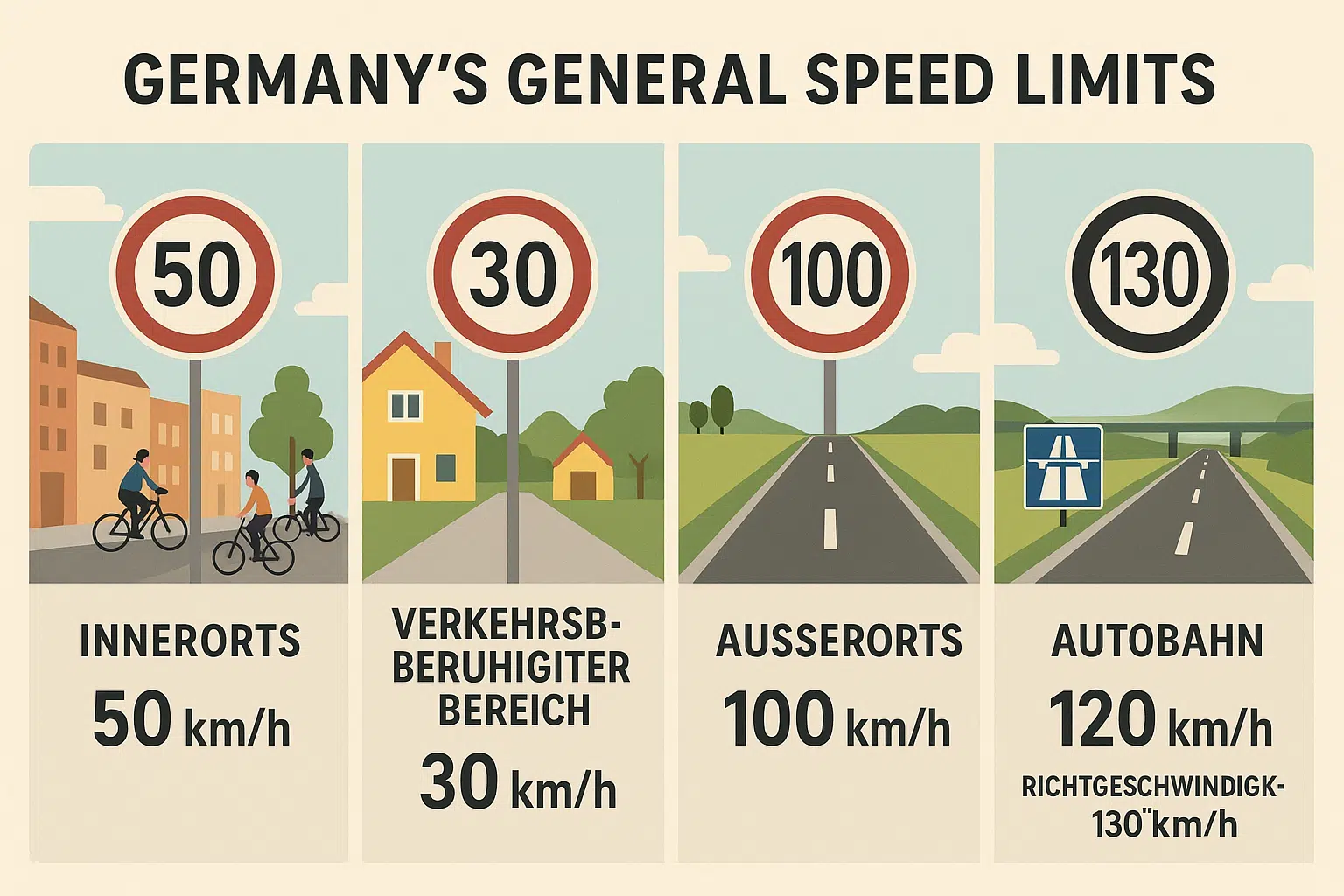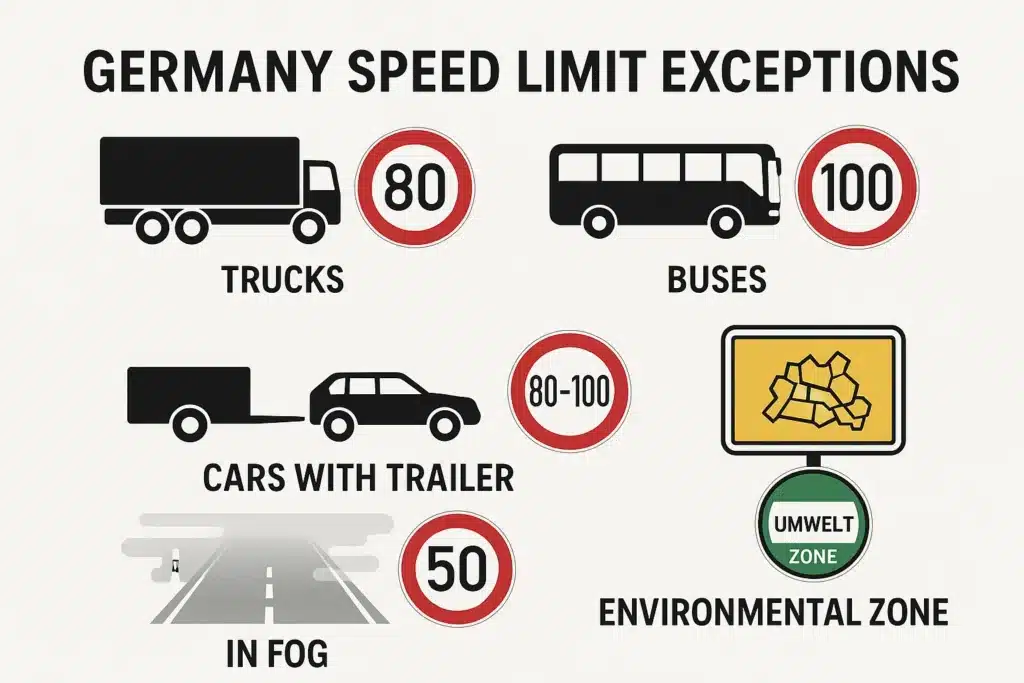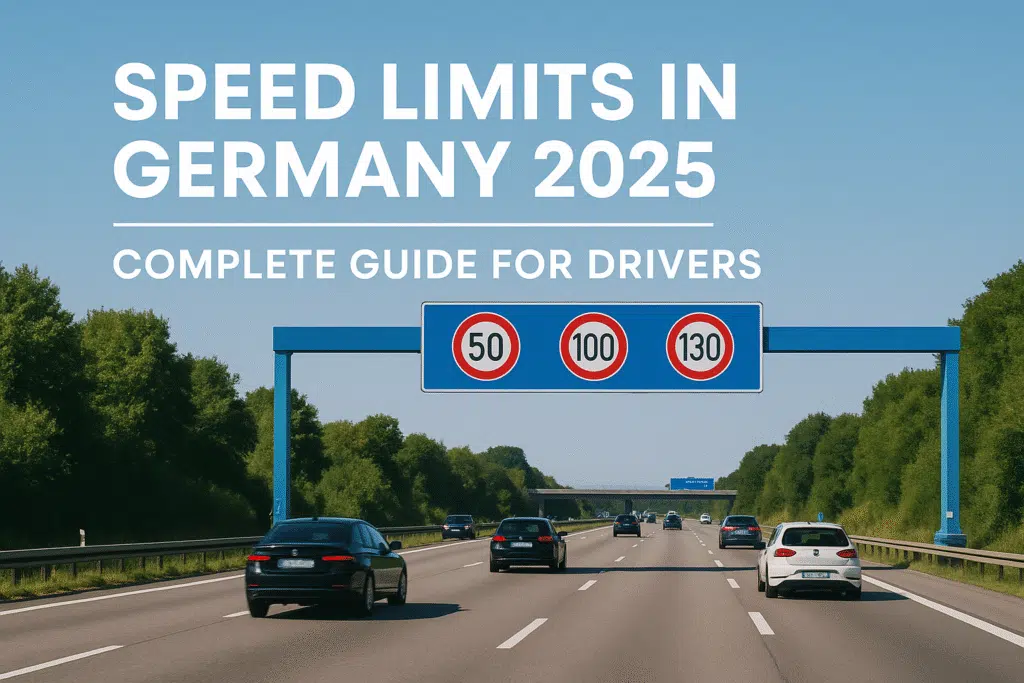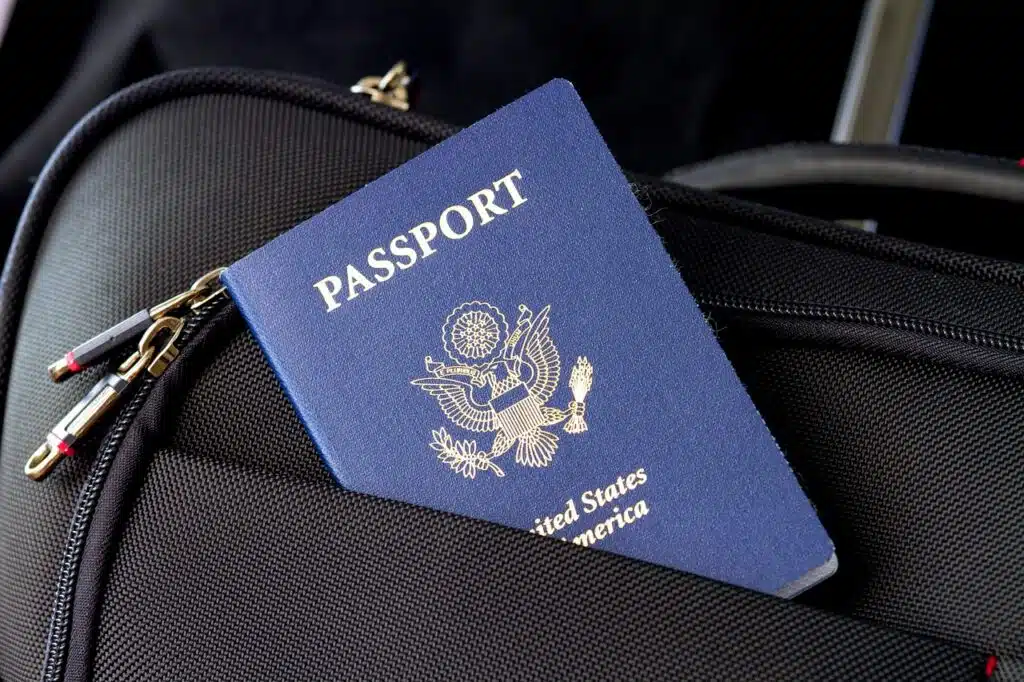Are there really no limits on certain roads? The response to this is yes, but the truth is not as simple as most people tend to believe. Germany has gained global recognition because of its Autobahn, a network of highways that, in reality, has no overall speed limit in large portions of it. Drivers all over the world have the dream to drive at 180 or even 200 km/h, the legal speed limit.
In this blog, I, Lucas, will take you through all that you should know about speed limits in Germany. You will get to know about the general city, rural roads, highways, the real truth about the Autobahn, exceptions, and special cases.
What is the Speed Limit in Germany?
We are talking of the legal maximum speed at which drivers are permitted to drive in various types of roads by the Speed Limit of Germany. In comparison with other countries, where all highways have one national limit, Germany has a distinct system that involves strict control with some freedom.
- The speed limit in cities is usually 50km/h (31mph), and in residential or school locations, it is normally 30km/h (19mph).
- The speed limit on the rural roads is 100km/h (62 mph) except otherwise.
- It tends to be limited to expressways and controlled highways at 120km/h (75 mph).
- Autobahn: There is no maximum speed, and a recommended speed of 130 km/h (81 mph) on the Autobahn, some of which is undivided.
General Speed Limits in Germany

You cannot pull out in Germany and suppose that there are no rules. Although the Autobahn is known to be limitless, the majority of roads in Germany have very definite speed limits.
Speed Limits in Urban Areas
In the urban areas, towns, and villages, the general speed limit is 50 km/h (31 mph). This is very strictly applied due to pedestrian safety, cyclists, and heavy traffic in developed regions.
- There are cases where the limit in residential areas is reduced to 30 km/h (19 mph).
- School speed limits and localities around kindergartens may impose very high speed limits.
Speed Limits Outside Built-Up Areas
Outside the city, on the rural roads, the maximum limit is 100 km/h (62 mph) unless otherwise indicated.
But things such as road works, sharp curves, or weather might compel you to drive more slowly. I would never suggest that you go against the signs and think that you can always drive at 100 km/h.
Expressways and Highways
In dual carriageways and highways that are not shared with the unrestricted Autobahn, the speed is normally 120 km/h (75 mph).
Recommended Speed on the Autobahn
Germany has a so-called Richtgeschwindigkeit, a recommended speed of 130 km/h (81 mph) on the Autobahn. This is not a law, but when you drive faster and are in an accident, it proves that you are partly to blame.
The Autobahn: Myths vs Reality
The Autobahn is among the most interesting aspects of driving in Germany. Most individuals in the world think that it is a no-holds-barred battlefield. But that is only partly true.
The Entire Autobahn Has No Speed Limit
The fact is, approximately 70 percent of the Autobahn is not speed-limited. Nevertheless, approximately 30 percent of the Autobahn is limited, particularly within the vicinity of cities, intersections, or accident-prone situations.
Unlimited Speed, No Consequences?
No, you can legally drive on free stretches and 200 km/h or more. However, when an accident takes place, the insurance and the courts can think that you were speeding.
Germans Always Drive Super Fast
Not true. The majority of the German drivers adhere to 120-140 km/h. Trucks have an 80km/h (or 100km/h on a special permit) speed, and therefore, there is a natural balancing of traffic.
Read Also: 7 Steps to Move to Europe from the USA in 2025 (Visas & Costs)
Speed Limit Exceptions & Special Rules

Germany has several exceptions and unique driving rules that you, as a driver, need to know.
For Trucks and Buses
- Trucks over 3.5 tonnes: max 80 km/h.
- Buses: max 100 km/h on highways.
For Trailers
When you are pulling a trailer, you are normally limited to 80 km/h, but in some instances, it is 100 km/h with a special dispensation.
Weather-Related Speed Limits
The law asks you to drive at a slower pace in fog, heavy rain, or snow. This is so, say, when visibility is less than 50 meters, the maximum is 50 km/h even on the Autobahn.
Environmental Zones
In some city centers, environmental restrictions apply. Speed can be reduced to control air pollution.
Speeding Fines in Germany
Now, let me explain the part that most drivers fear: fines. Germany takes speeding very seriously, and the fines are not only financial but can also involve losing your license.
Speeding Fines Inside Built-Up Areas
- Up to 10 km/h over: €30 fine.
- 11–15 km/h over: €50 fine.
- 16-20 km/h exceedance: fined and 1 penalty point.
- More than 50 km/h: fines up to €800, in Flensburg, the license and points are suspended.
Speeding Fines Outside Built-Up Areas
The fines are slightly lower outside cities, but you can still lose your license if you exceed by 40–60 km/h.
On the Autobahn
In case of driving recklessly or too fast for conditions, even if it is in a no-limit zone, you may still face charges of endangering traffic.
No Autobahn Speed Limit: The Reason

Many people wonder: why does Germany still allow unrestricted speed zones when almost all other countries have limits?
Historical and Cultural Reasons
Since the 1930s, the Autobahn has been an engineering pride of Germany. Politically, there has been a challenge to have a general speed limit, as most drivers view it as an individual freedom.
The Safety Argument
Interestingly, the rate of road fatality in Germany is less than in several countries that have strict limits. Accidents are minimized by severe training of drivers, quality cars, and a strict driving culture.
The Environmental Debate
In recent years, there has been a strong debate about introducing a general limit to cut CO₂ emissions. Some studies show that setting a 120 km/h limit could save millions of tons of CO₂ per year.
Tips for Driving in Germany
In case you are going to drive in Germany, I want to tell you about some personal tips that will help you to be safe and not be fined.
Always Stay in the Right Lane
Passing is only done on the left lane in the Autobahn. You should always return to the right after overtaking.
Watch for Speed Signs
Temporary speed limits are common near construction zones. These are strictly monitored with cameras.
Overtaking Rules
Never overtake from the right. It is illegal and dangerous.
Respect Tailgating Laws
Closely following is fined heavily. Maintain a safe distance, most particularly at high speed.
Use Winter Tires in Snow
Their winter tireless driving in wintry climates may attract fines and insurance problems.
Follow the Advisory Speed
Although you can be tempted to drive your car up to 200km/h, consider safety and responsibility. The 130km/h is there because it is recommended.
FAQs
How high are speeding fines?
They range from €30 to €800, with possible license suspension.
Do tourists follow the same speed rules?
Yes, the same rules of German traffic should be obeyed by all drivers.
What is the truck speed limit?
The trucks weighing more than 3.5 tonnes are operated at 80km/h.
Is the Autobahn safe?
Yes, it is among the most secure highways in Europe.
Read Also: Germany International Driving Licence: Apply Fast & Avoid Fines
Final Words
The process of driving in Germany is a special experience, and the only way to do it safely and with pleasure is to get to know the rules of the speed limits. Although the Autobahn has the excitement of free driving in parts, Germany has one of the most restrictive limits both in urban areas, rural roads, and restricted highway areas. It is this balance of freedom and discipline that makes the German road system exciting as well as safe.
When you, as a driver, respect the rules, observe the speed signs, and put safety first in mind, you will not just evade hefty fines, but you will also have a glimpse of why the German roads are envied worldwide.


